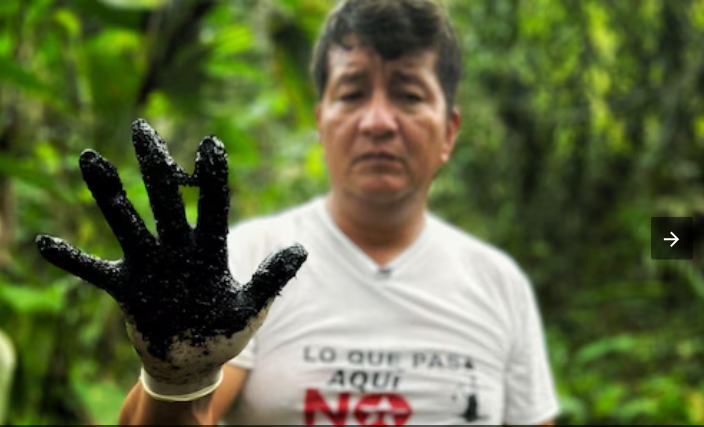
“In a’ingae, my native language, the words oil, contamination, and cancer did not exist until Texaco arrived on our lands,” says Don Arturo, an elder among the A’i Kofán Siangoé people, one of Ecuador’s 11 Amazonian communities. The A’i Kofán worldview is based on an intimate relationship with nature and its environment, and a strong spiritual connection with its ancestral territory.
Don Arturo lives in Dureno, a community located on the banks of the Aguarico River. The river crosses the province of Sucumbíos in the northwestern reach of the Ecuadorian Amazon, near the border with Colombia. To get to his home, built with materials such as wood and zinc, you have to cross the river by raft. Don Arturo says that when he was a child, the river was crystal clear and full of fish, which allowed him and his community to make a living. In those days, everyone in the community was healthy and led quiet lives.
As Don Arturo’s memories gradually fade, he says he’s compelled to remember and share his story. At 72, nostalgia takes him back to when he was 13 years old. The petroleum company Texaco (now Chevron) had just arrived on his land. “White men arrived in the Amazon with huge machines that razed the forest and the community’s land.”
To this day, he harbors terrible memories of having witnessed abuses by company workers, worst among them the rape of an indigenous woman.
Don Arturo, an A’i Kofán indigenous man, resides along the banks of the Aguarico River in Sucumbíos province, in the Ecuadorian Amazon. He lives with the harsh consequences of oil industry exploitation. Photo by Andrés Cornejo Pinto for palabra
In a soft voice and broken Spanish, he recounts how, from one moment to the next, neighbors noticed that cattle began to die, and his relatives suffered from unfamiliar diseases.
For him and his people, the arrival of the petroleum company meant a break in their way of life and the loss of everything they knew and loved.
Don Arturo now has prostate cancer. The Aguarico River, once crystal clear and full of fish, is polluted and empty. These days residents must leave their land to buy food in the city. The life he knew is just a memory.
The story of Don Arturo is like that of thousands of Amazonian indigenous people living with the consequences of oil exploitation in Ecuador, and neglect and abandonment by the government. Thirty years have passed since the community began to demand justice and struggle against official impunity and a hostile and precarious environment.
Almost 60 years ago, U.S.-based Texaco Gulf arrived to operate oil wells in the Ecuadorian jungle. The company’s time in Ecuador lasted until 1990. A decade later, the company became part of Chevron.
Chevron evokes in the memories of many Ecuadorians and environmental organizations that of one of the worst environmental disasters in history. According to documents from Ecuador’s Ministry of Foreign Affairs and Human Mobility (MREMH, in Spanish), the company failed to comply with proper environmental protocols and dumped millions of gallons of toxic water and oil residue into rivers and streams adjacent to oil wells, spreading pollution across some 400,000 hectares.
According to a 2008 study, environmental damage was followed by a decline in the health of the local indigenous population, including children, who suffered from chronic and congenital diseases that in many cases led to death.
The document found that those who live in places surrounding the exploited area, in the provinces of Orellana and Sucumbíos, have three times more cancers than the rest of the country. The figure is higher when compared to communities in the same Amazon region not exposed to contamination. It is estimated that around 30,000 people were affected, belonging to different indigenous groups and farming communities.
A gas flare in Lago Agrio, a common device used in the oil-rich regions of the Ecuadorian Amazon to burn off excess gas and extraction waste. In the photo, Donald Moncayo, a prominent advocate in the fight for justice against Texaco Chevron’s pollution. Photo by Andrés Cornejo Pinto for palabra
Donald Moncayo, a community leader from Lago Agrio and spokesperson for the organization Union of Those Affected by Texaco (UDAPT, in Spanish), remembers clearly the tragic experience of his mother, who suffered three miscarriages. Moncayo says that happened after Texaco arrived. He says he’s convinced there were more in the same community. A 2004 investigation found that the risk of having a miscarriage was more likely in communities near oil wells, versus those free of contamination.
But the tragedy did not end there. Cancer was discovered in residents of the area. During those years, he recalls, residents were being led to believe that the oil was medicinal. Some neighbors rubbed their bodies with the traces of oil that began to appear in the forest, believing that this would heal various ailments. They even walked barefoot over black puddles of oil, convinced that this black liquid was a source of healing.